|
Centrip Editorial Board
Ise Shima Must Eats: Centrip Japan's Complete Guide to Ise Shima

You have to try the seafood in Ise Shima. Japanese confections and Udon are also traditionally popular foods. Marine and livestock products, produce, traditional Japanese confections, etc, In Japan Ise Shima is an eminent culinary tourist spot that you can enjoy to your heart's content.
Akafuku
 Azuki (sweet red beans) are boiled, ground, and strained to
make Koshian and then wrapped in mochi. An Ise specialty that
is known all across Japan. As a souvenir is it a big seller
but it can't be stored for long. Established in 1707, in Ise
Toba Akafuku should be eaten along with hot tea and can be
enjoyed in drinking and eating establishments. Many people
enjoy Akafuku in spring as a topping for shaved ice, and in
winter it is eaten in Zensai (a sweet red bean soup).
Azuki (sweet red beans) are boiled, ground, and strained to
make Koshian and then wrapped in mochi. An Ise specialty that
is known all across Japan. As a souvenir is it a big seller
but it can't be stored for long. Established in 1707, in Ise
Toba Akafuku should be eaten along with hot tea and can be
enjoyed in drinking and eating establishments. Many people
enjoy Akafuku in spring as a topping for shaved ice, and in
winter it is eaten in Zensai (a sweet red bean soup).
Matsuzaka Beef
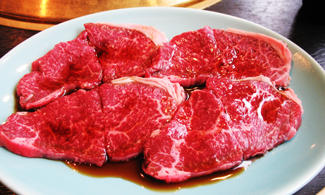 Meat good enough to be a work of art, Matsuzaka beef enjoys
incredible brand power and is an extremely famous type of beef
in Japan. Raised using traditional techniques in addition to
stored under strict conditions, as result, it has become
Japan's number one beef in both name and reality. A sweet and
rich scent, healthy, with high-quality fat, and
melt-in-your-mouth tenderness, are the characteristics of
Matsuzaka beef.
Meat good enough to be a work of art, Matsuzaka beef enjoys
incredible brand power and is an extremely famous type of beef
in Japan. Raised using traditional techniques in addition to
stored under strict conditions, as result, it has become
Japan's number one beef in both name and reality. A sweet and
rich scent, healthy, with high-quality fat, and
melt-in-your-mouth tenderness, are the characteristics of
Matsuzaka beef.
Craft Beer
 The award-winning beer of Ise Kadoya Microbrewery, in Ise, is
the recipient of prizes both domestic and international and
enjoys a well-deserved reputation. Their Malt contains no
added pesticides or artificial fertilizers and is crafted with
great care. Unfiltered to maintain the beer's original flavor,
and unpasteurized original tasting draft beer. Unfiltered to
maintain the beer's original flavor, and unpasteurized to
create a real draft beer.
The award-winning beer of Ise Kadoya Microbrewery, in Ise, is
the recipient of prizes both domestic and international and
enjoys a well-deserved reputation. Their Malt contains no
added pesticides or artificial fertilizers and is crafted with
great care. Unfiltered to maintain the beer's original flavor,
and unpasteurized original tasting draft beer. Unfiltered to
maintain the beer's original flavor, and unpasteurized to
create a real draft beer.
Ise Tea
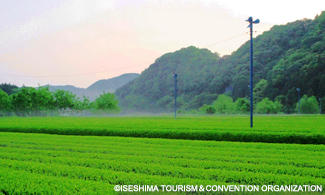 Ise is Japan's 3rd largest tea producer. The leaves of Ise tea
are thick and heavy. From the moment you pour the tea into
your cup, experience the soothing aroma, and enjoy a balance
of sweetness and bitterness. Just as the shapes of mountain
and seas can differ, so can the tastes of Ise teas. You'll
love tasting and comparing the different flavors.。
Ise is Japan's 3rd largest tea producer. The leaves of Ise tea
are thick and heavy. From the moment you pour the tea into
your cup, experience the soothing aroma, and enjoy a balance
of sweetness and bitterness. Just as the shapes of mountain
and seas can differ, so can the tastes of Ise teas. You'll
love tasting and comparing the different flavors.。
Tekone Sushi
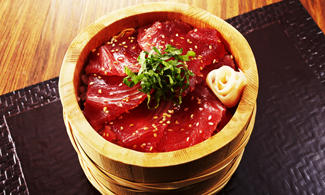 This is not your ordinary sushi, rice is put into a barrel and
then raw fish is put on top until you can no longer see the
rice. Sushi rice is mixed with vinegar, then bonito, tuna, and
other red meat fish are added on top. Then soy sauce is added
to the raw fish. It was once a dish that fishermen would eat
in celebration of a big catch.
This is not your ordinary sushi, rice is put into a barrel and
then raw fish is put on top until you can no longer see the
rice. Sushi rice is mixed with vinegar, then bonito, tuna, and
other red meat fish are added on top. Then soy sauce is added
to the raw fish. It was once a dish that fishermen would eat
in celebration of a big catch.
Maruten's Isoage
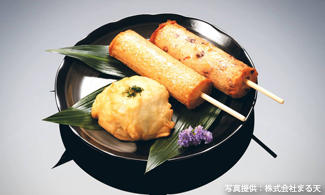 Isoage is a combination of fish shavings, seafood, and
vegetables mixed together and deep-fried. It has become a
popular food to get at Maruten and eat while walking through
Oharaicho. There you can purchase them made fresh and will see
many people walking while eating them. They are also popular
as a packaged souvenir. Isoage doesn't often appear on
restaurant menus but is a side dish that is often eaten by
Japanese people.
Isoage is a combination of fish shavings, seafood, and
vegetables mixed together and deep-fried. It has become a
popular food to get at Maruten and eat while walking through
Oharaicho. There you can purchase them made fresh and will see
many people walking while eating them. They are also popular
as a packaged souvenir. Isoage doesn't often appear on
restaurant menus but is a side dish that is often eaten by
Japanese people.
Ise Ebi (Spiny Lobster)
 Ise Ebi (Spiny Lobster) is the most famous kind of lobster in
Japan and is known as the King of Lobsters. Ise Ebi is between
20cm to 30cm long, and are covered in a hard shell which is
firm to the touch. The meat inside is transparent, and when
eaten as sashimi it has a sweet taste. Boiled, or fried the
meat gains a nice chewy consistency. The nutrients of the sea
contribute to the deliciousness of Ise Ebi.
Ise Ebi (Spiny Lobster) is the most famous kind of lobster in
Japan and is known as the King of Lobsters. Ise Ebi is between
20cm to 30cm long, and are covered in a hard shell which is
firm to the touch. The meat inside is transparent, and when
eaten as sashimi it has a sweet taste. Boiled, or fried the
meat gains a nice chewy consistency. The nutrients of the sea
contribute to the deliciousness of Ise Ebi.
Anori Blowfish
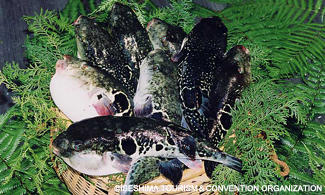 Anori Blowfish, are tiger blowfish caught in the bay of Ise,
sometimes weighing over 700kg, and cannot be caught between
October and February. They are born in the spring and in the
fall they start to appear during early high tide. They are
well-known for being quite firm. Blowfish aficionados prize
this species for its sweetness and chewiness. You'll only find
it in this area—at local inns and restaurants. You'll only
ever find it sold in small batches.
Anori Blowfish, are tiger blowfish caught in the bay of Ise,
sometimes weighing over 700kg, and cannot be caught between
October and February. They are born in the spring and in the
fall they start to appear during early high tide. They are
well-known for being quite firm. Blowfish aficionados prize
this species for its sweetness and chewiness. You'll only find
it in this area—at local inns and restaurants. You'll only
ever find it sold in small batches.
Oysters
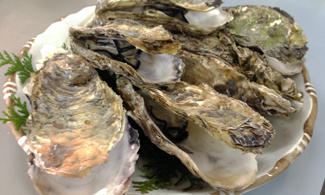 Toba is Japan's number one producer of oysters. The calm waves
and abundant food makes the area quite suitable for
aquaculture. In just one year, soft plump oysters will be
ready for sale. Because of the carefully maintained
environment, there are many places in the surrounding area
that serve raw oysters. These oysters are also delicious when
grilled or deep-fried. They are extremely juicy with a rich
flavor.
Toba is Japan's number one producer of oysters. The calm waves
and abundant food makes the area quite suitable for
aquaculture. In just one year, soft plump oysters will be
ready for sale. Because of the carefully maintained
environment, there are many places in the surrounding area
that serve raw oysters. These oysters are also delicious when
grilled or deep-fried. They are extremely juicy with a rich
flavor.
Ise Udon Noodles
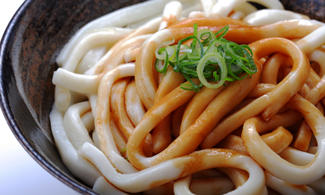 These udon noodles aren't your ordinary udon. The noodles are
particularly soft and almost melt in your mouth. The soup they
are served in is made with tamari soy sauce, making them
almost black. They are topped with bonito fish flakes as well.
It's said that the reason the noodles are so soft is to
accommodate travelers with stomachs weak from long travel,
before the age of trains and cars.
These udon noodles aren't your ordinary udon. The noodles are
particularly soft and almost melt in your mouth. The soup they
are served in is made with tamari soy sauce, making them
almost black. They are topped with bonito fish flakes as well.
It's said that the reason the noodles are so soft is to
accommodate travelers with stomachs weak from long travel,
before the age of trains and cars.
Toraya Uiro
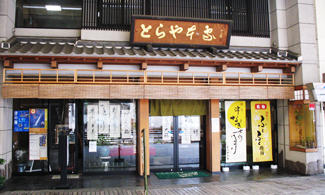 Uiro is a type of Japanese confection made by steaming rice
flour mixed with sugar and hot water. It is eaten all over
Japan but the uiro made in Ise is special because it is made
with brown sugar. No preservatives are used in the cooking
process so the uiro needs to be eaten right away. In recent
years, a number of season variations have been developed,
adding up to around 35 types in all. The light flavor and
texture of uiro have made it one of the most popular Japanese
sweets there is.
Uiro is a type of Japanese confection made by steaming rice
flour mixed with sugar and hot water. It is eaten all over
Japan but the uiro made in Ise is special because it is made
with brown sugar. No preservatives are used in the cooking
process so the uiro needs to be eaten right away. In recent
years, a number of season variations have been developed,
adding up to around 35 types in all. The light flavor and
texture of uiro have made it one of the most popular Japanese
sweets there is.
Dried Fish
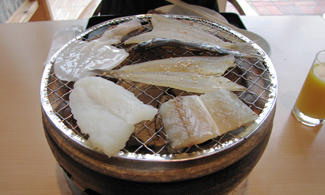 Himono is the Japanese term for dried fish. Dried fish has a
rich, aged taste. The drying process locks in the flavor.
Because of the low moisture of the resulting product, the
dried fish has a long shelf-life. Dried fish is seasonal and
the types of fish available for sale changes over the course
of the year. The deep flavor is unique to each kind of dried
fish and it is a staple of the Japanese breakfast.
Himono is the Japanese term for dried fish. Dried fish has a
rich, aged taste. The drying process locks in the flavor.
Because of the low moisture of the resulting product, the
dried fish has a long shelf-life. Dried fish is seasonal and
the types of fish available for sale changes over the course
of the year. The deep flavor is unique to each kind of dried
fish and it is a staple of the Japanese breakfast.
Read More
- What is Ise Shima : Centrip Japan's Complete Guide to Ise Shima
- All Around Ise Shima : Centrip Japan's Complete Guide to Ise Shima
- Ise Shima Transportation: Centrip Japan's Complete Guide to Ise Shima
- Must-see places at Ise-Shima: Centrip Japan's Complete Guide to Ise Shima
- Ise Shima Most Popular Souvenir: Centrip Japan's Complete Guide to Ise Shima

